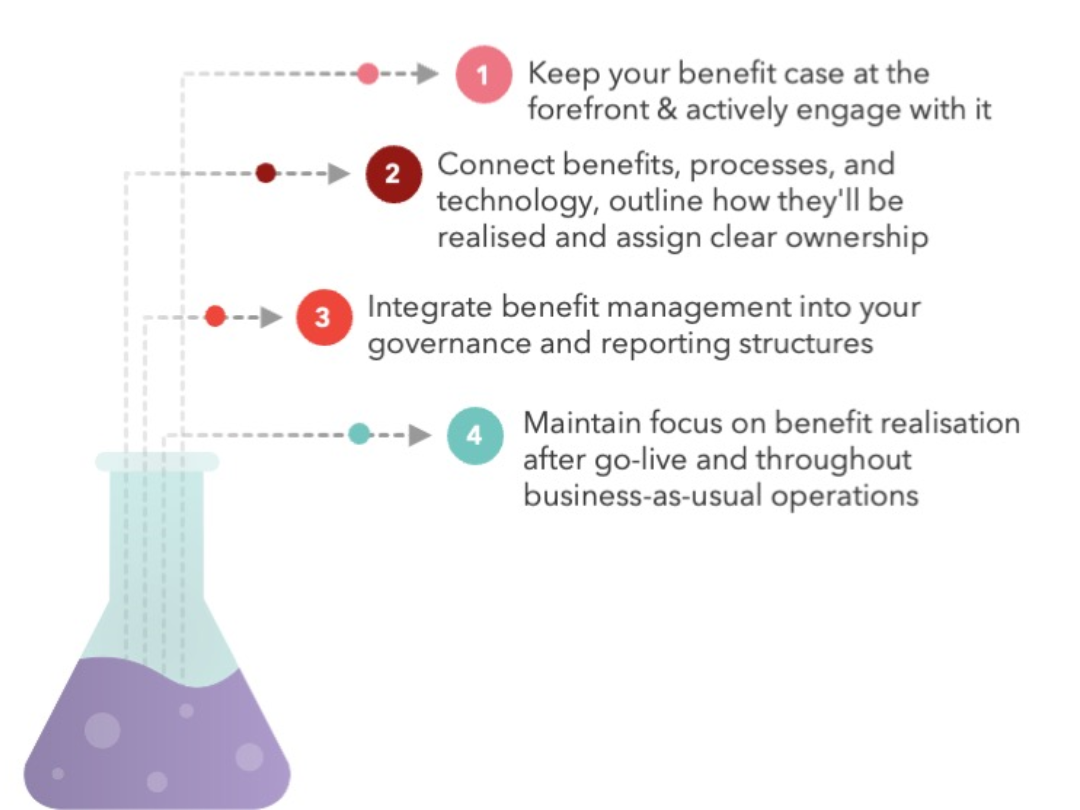
Delaware’s formula for sustaining a value driven SAP implementation
- SAP
Here at Delaware, we believe we’ve cracked the formula for sustained value-driven decision making in your project - and it's quite straightforward...

Here at Delaware, we believe we’ve cracked the formula for sustained value-driven decision making in your project - and it's quite straightforward...
Our approach revolves around utilising the fundamentals of effective program implementation, enhanced by a touch of “connected transformation”. Keep reading for a full overview of our 4-step formula for sustaining a value-driven implementation...
So, you’ve kicked off your benefit case and early discovery work. You’re clear what needs to be transformed, what you’re keeping and what your approach and timeline look like. Job done, time to crack on, right?
Nope, it’s not. Yet, this is exactly what most organisations do, and it leads to benefit erosion, higher implementation risk (and cost), eye watering costs to fix your programme’s failures and uncomfortable questions about how you secured funding. But, it doesn't have to be this way. In fact, here at Delaware, we believe we’ve cracked the formula for sustained value-driven decision making in your project - and it's quite straightforward!
Our approach revolves around utilising the fundamentals of effective program implementation, enhanced by a touch of “connected transformation”. Here an overview of our 4-step formula for sustaining a value-driven implementation:

Seems like common sense, doesn't it? Well, it should be, but we often see the fallout from failed programs or the turbulence following a rocky implementation, where the notion of a benefit case was merely a token gesture to secure funding—or, in some unfortunate cases, non-existent! Predictably, these implementations fell short of their intended goals.
In fact, these clients were the tip of the iceberg of “failed” implementations. The issue was so widespread that, at times in the last 5-10 years, success rates for SAP implementations dropped as low as 25%. Based on my 20 years of first-hand experience, it's clear that the root cause often lies in neglecting to integrate benefits into the implementation DNA.
This omission dilutes focus, invites scope creep and divergence and shifts essential business decisions into mere technical discussions, with no real focus on the macro-outcomes you need to achieve.
Ensuring that benefits align with tangible scope items is imperative.
While it may seem like the most straightforward step in the process, it's a pivotal determinant of success. Ensuring that benefits align with tangible scope items is imperative. Without this alignment, tracking decision-making that could undermine these benefits during the design, construction, and testing phases becomes an insurmountable challenge.
Moreover, it hinders a benefit owner's ability to assume genuine responsibility for benefit realisation. Decision-making becomes obscure, the consequences of decisions become ambiguous, and the clarity of the project's direction becomes distorted.
This may seem mundane, but it's vital for securing value in your implementation. You must review, discuss, and track all decisions making that affects your business case. While Step 2 simplifies this process, it requires discipline to ensure that your governance forums prioritise benefit impact and dilution.
The composition of these governance forums is also crucial to your success. Responsibility for most benefit realisation lies with your business, not IT. So, it's essential to make them mandatory participants in program-related decision-making, ensuring their active involvement in the intricacies of SAP program governance. This forms the cornerstone of a holistic transformation, rather than one solely driven by IT.
An effective benefit-driven implementation streamlines your journey to go-live and positions you for success. But a smooth go-live and quick transition from hyper-care don't mark the end of the journey. In some cases, even after implementing robust process and system checking during hyper care, issues related to 'adoption' or 'design' arise three months later.
Delaware distinguishes itself by advocating for and aiding in monitoring process performance, adherence, and effectiveness. Our secret sauce lies in using innovative process mining tools that simplify and automate the arduous task of process monitoring. These tools eliminate manual report handling and complex analysis, providing effortless real-time insights and actionable suggestions. Implementing them empowers global process owners to make data-driven decisions, enhancing agility and maintaining a value-driven focus in all business operations
This approach embeds continuous improvement to such an extent that transformation becomes an ongoing evolution rather than a sporadic, painful leap.
Now that you’re thinking about the 6 months post go-live and the operational excellence Nirvana that awaits you, it’s worth taking a step back and remembering you’ve only just completed your benefit case - or are in the middle of it.
So, the four steps above are all part of your future and still need to be planned, structured, and implemented. If they’ve resonated with you, and you can see the need for them, but are struggling with how to do it, get in touch.
